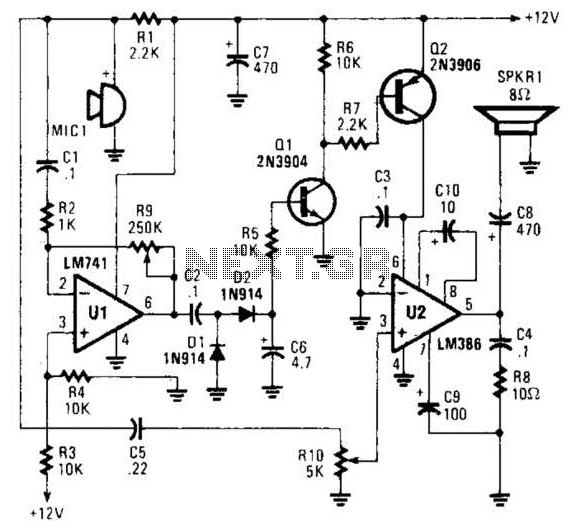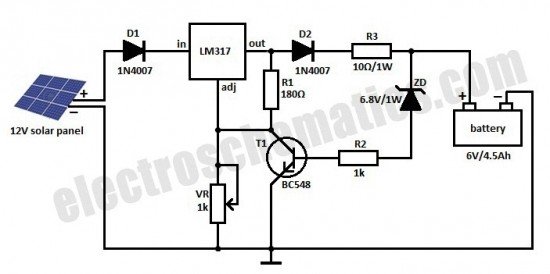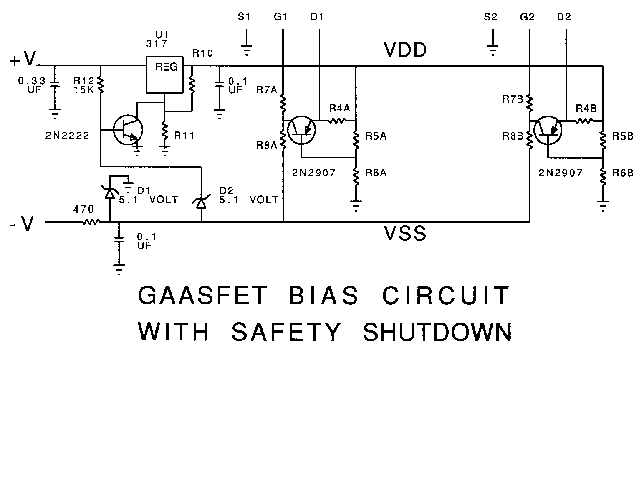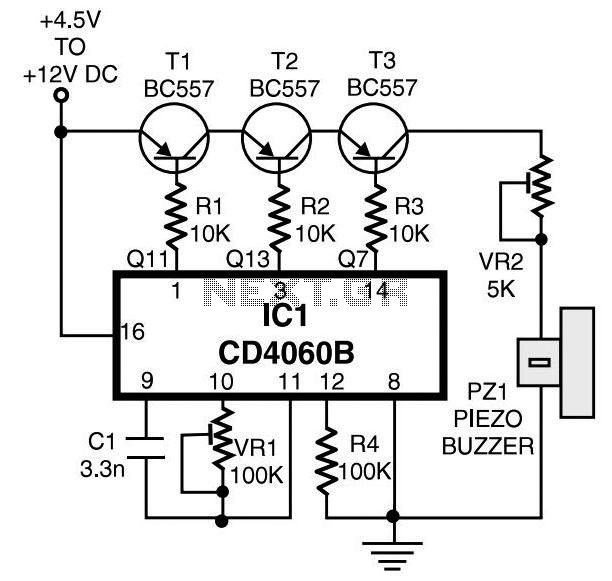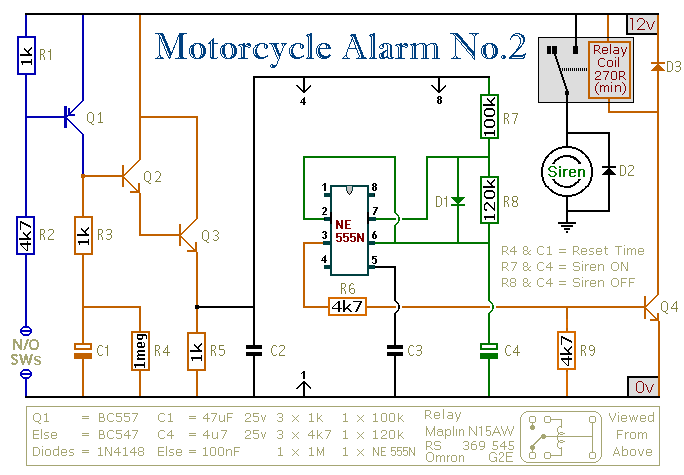
Water Activated Alarm circuit
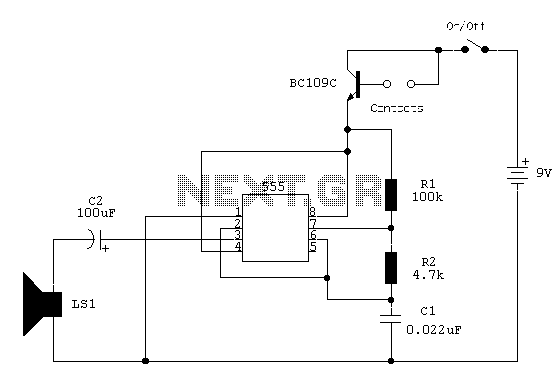
The circuit utilizes a 555 timer configured as an astable oscillator, powered by the emitter current of a BC109C transistor. In dry conditions, the transistor remains off due to the absence of bias current. However, when the probes become wet, the transistor conducts, triggering the alarm. An On/Off switch is included in the design. It is important to use a non-reactive metal for the probe contacts; gold or silver-plated contacts from an old relay are suitable. Alternatively, copper strips from veroboard can be used, although they will oxidize over time. The low current in the base circuit means that the increased impedance from oxidation is not a significant issue. A base resistor is unnecessary, as the transistor operates in an emitter follower configuration, with the emitter impedance limiting the current.
The circuit operates as a moisture detection system, leveraging the properties of the 555 timer and the BC109C transistor. The 555 timer, in astable mode, generates a continuous square wave output that can be used to drive a buzzer or other alarm mechanism when moisture is detected. The BC109C transistor serves as a switch that activates the alarm.
In the dry state, the probes do not conduct any current, keeping the transistor in the off state. As moisture bridges the gap between the probes, a small current flows through the base of the BC109C, turning it on and allowing a larger current to flow from the collector to the emitter. This action activates the alarm, alerting users to the presence of moisture.
The inclusion of an On/Off switch allows for manual control of the circuit, enabling users to deactivate the system when not in use. The choice of probe material is critical for the longevity and reliability of the circuit. Non-reactive metals like gold or silver are preferred due to their resistance to corrosion and oxidation, which could otherwise affect the performance of the moisture sensor over time. If cost is a concern, copper strips can be utilized; however, users should be aware that they will require periodic maintenance or replacement due to oxidation.
The design does not require a base resistor, as the transistor is configured in an emitter follower setup. In this configuration, the emitter current is primarily determined by the load connected at the emitter, which serves as the current limiter. This simplifies the circuit design and reduces component count, making it more efficient and cost-effective for moisture detection applications.The circuit uses a 555 timer wired as an astable oscillator and powered by the emitter current of the BC109C. Under dry conditions, the transistor will have no bias current and be fully off. However as the probes get wet the transistor will conduct and sounding the alarm.An On / Off switch is provided and remember to use a non-reactive metal for the probe contacts. Gold or silver plated contacts from an old relay may be used, however a cheap alternative is to wire alternate copper strips from a piece of veroboard.
These will eventually oxidize over but as very little current is flowing in the base circuit, the higher impedance caused by oxidization is not important. No base resistor is necessary as the transistor is in emitter follower, current limit being the impedance at the emitter (the oscillator circuit).
The circuit operates as a moisture detection system, leveraging the properties of the 555 timer and the BC109C transistor. The 555 timer, in astable mode, generates a continuous square wave output that can be used to drive a buzzer or other alarm mechanism when moisture is detected. The BC109C transistor serves as a switch that activates the alarm.
In the dry state, the probes do not conduct any current, keeping the transistor in the off state. As moisture bridges the gap between the probes, a small current flows through the base of the BC109C, turning it on and allowing a larger current to flow from the collector to the emitter. This action activates the alarm, alerting users to the presence of moisture.
The inclusion of an On/Off switch allows for manual control of the circuit, enabling users to deactivate the system when not in use. The choice of probe material is critical for the longevity and reliability of the circuit. Non-reactive metals like gold or silver are preferred due to their resistance to corrosion and oxidation, which could otherwise affect the performance of the moisture sensor over time. If cost is a concern, copper strips can be utilized; however, users should be aware that they will require periodic maintenance or replacement due to oxidation.
The design does not require a base resistor, as the transistor is configured in an emitter follower setup. In this configuration, the emitter current is primarily determined by the load connected at the emitter, which serves as the current limiter. This simplifies the circuit design and reduces component count, making it more efficient and cost-effective for moisture detection applications.The circuit uses a 555 timer wired as an astable oscillator and powered by the emitter current of the BC109C. Under dry conditions, the transistor will have no bias current and be fully off. However as the probes get wet the transistor will conduct and sounding the alarm.An On / Off switch is provided and remember to use a non-reactive metal for the probe contacts. Gold or silver plated contacts from an old relay may be used, however a cheap alternative is to wire alternate copper strips from a piece of veroboard.
These will eventually oxidize over but as very little current is flowing in the base circuit, the higher impedance caused by oxidization is not important. No base resistor is necessary as the transistor is in emitter follower, current limit being the impedance at the emitter (the oscillator circuit).
